I know a lot of the more experienced anglers moan when they pick up magazines and browse through websites only to see regular rig building features, but the fact remains that for both the monthly magazines and certainly for WSF, the most read articles and the most frequently asked questions are what rigs to use, when to use them and how to build them. It’s easy to forget that new anglers are coming in the fishing all the time and need the same advice we did when we started. Besides, there are so many variants on common rigs now that we can all learn something from time to time.
A recent question asked very simply, what was my favourite beach rig and the one I most commonly use? Not easy to answer for me being a full all rounder with literally scores of different rigs in my rig wallet to cover all the different situations and species I encounter. However I’ve settled on the two-hook clipped up rig, which I build slightly differently to those used by some other anglers. It is also one of the least used rigs by anglers elsewhere yet, is my most effective for general species.
TOP TIP
To build this rig you need to adapt a current rig accessory, the Mustad Multi Clip.
These are universal clips mainly made for holding longer hook snoods in place when clipping down. These have a ring at one end and a dog leg clip at the other. They are also small in comparison to standard bait clips.

Some years ago a friend and I realised that by cutting off the ring this makes the Multi Clip in to the smallest, neatest bait clip around. It’s basically a hollow coil of wire which the rig body line can slide through. I use these exclusively on many of my rigs nowadays instead of plastic bait clips which generally are too big and clumsy for small species rigs and certainly too obtrusive when fishing in daylight.
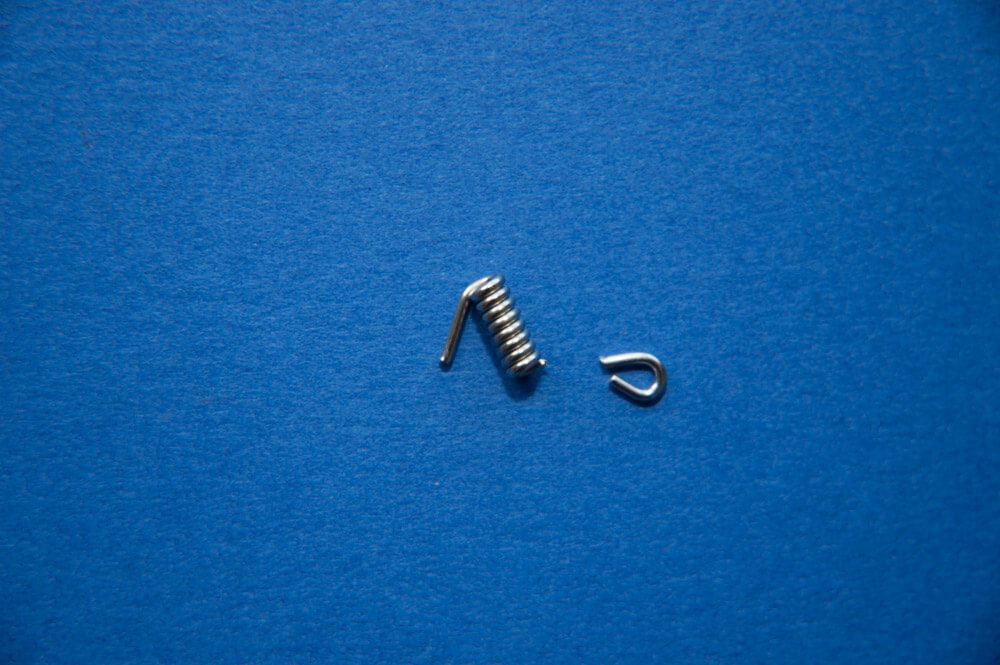
TWO-HOOK CLIPPED UP BUILD SEQUENCE
The build sequence is simple.
Start with 40-inches of 60lb clear mono.
At one end tie on a Gemini Lead Link.
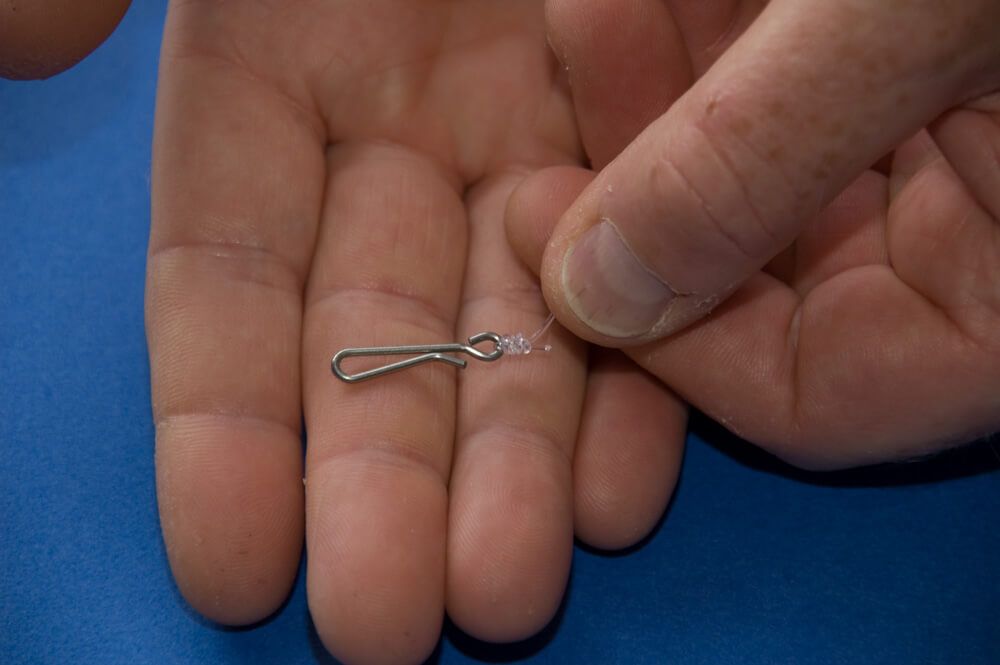
Now slide on a rig crimp, 3mm rig bead, size 10 rolling swivel, another bead and rig crimp. Crimp these in place 1-inch above the lead link.
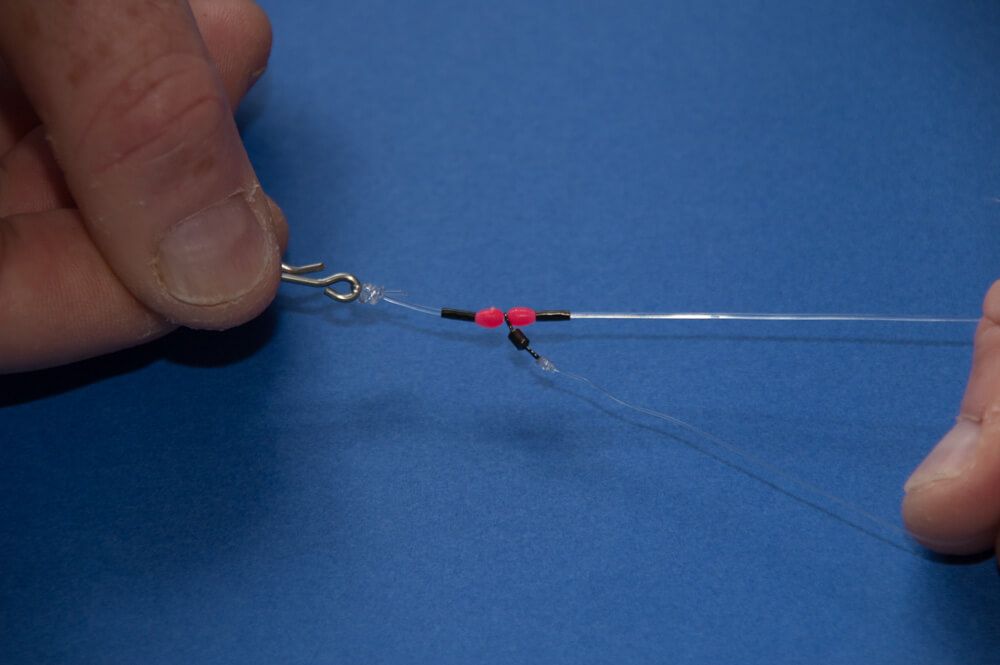
Slide on a Sakuma sliding rig crimp, a 3mm bead, the cut down Multi Clip in the inverted position, another bead and another crimp. Leave these loose for now.
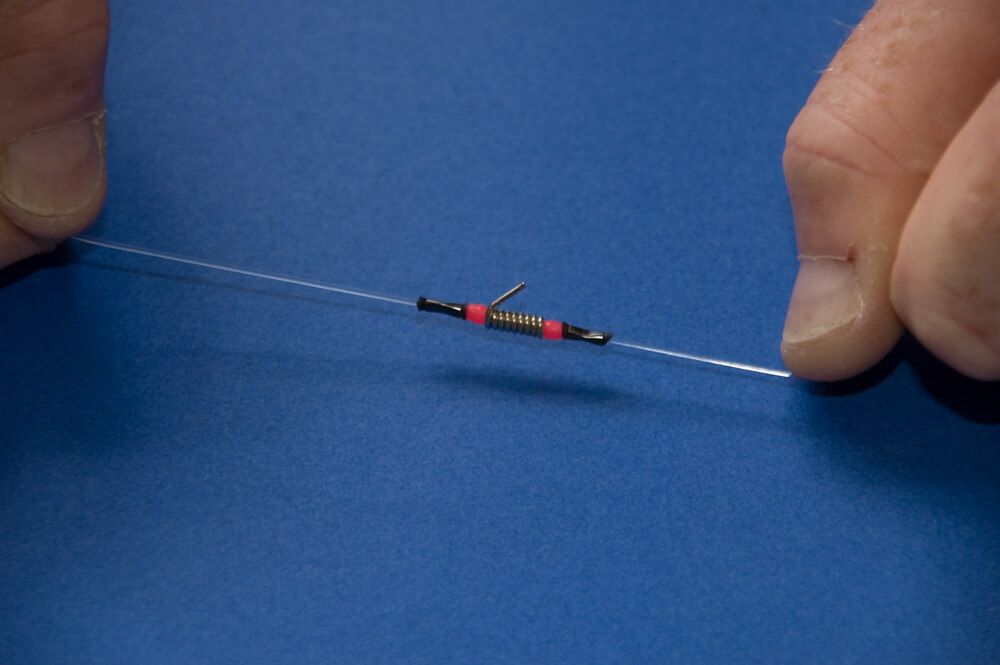
Slide on another crimp, bead and swivel sequence.
Slide on another sliding crimp, rig bead and inverted Multi Clip sequence.
Finish the main rig by tying on a strong size 4 rolling swivel.
The bottom and top hook snoods are 12 to 15-inches of 20lb Fluoro carbon.
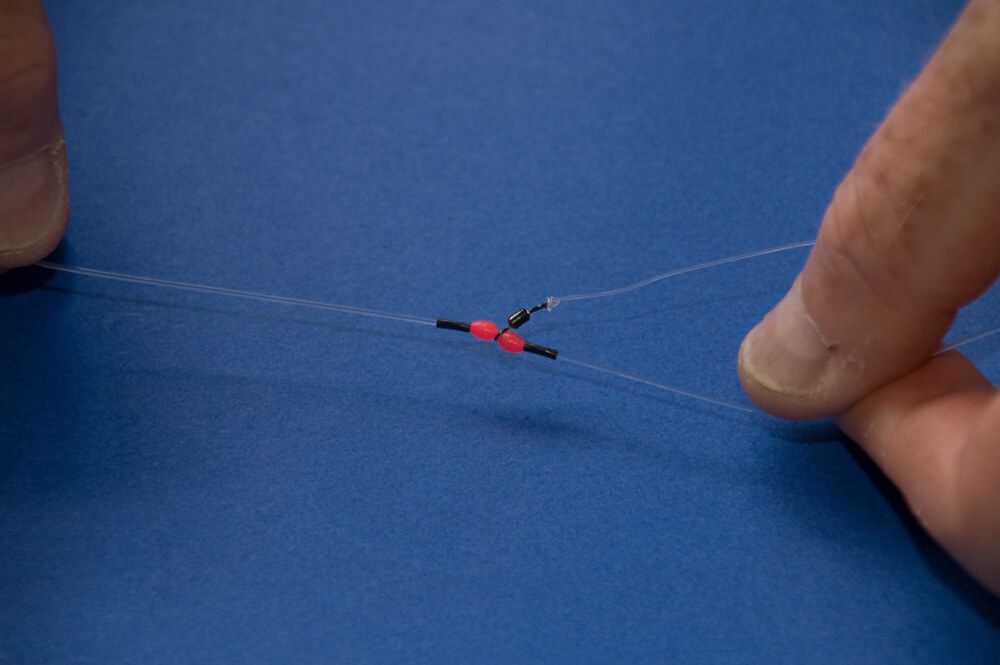
After tying to the snood swivels slide on a large rubber rig stop, then a single small luminous bead, and finish with a size 2 Kamasan Aberdeen B940 or Sakuma equivalent.
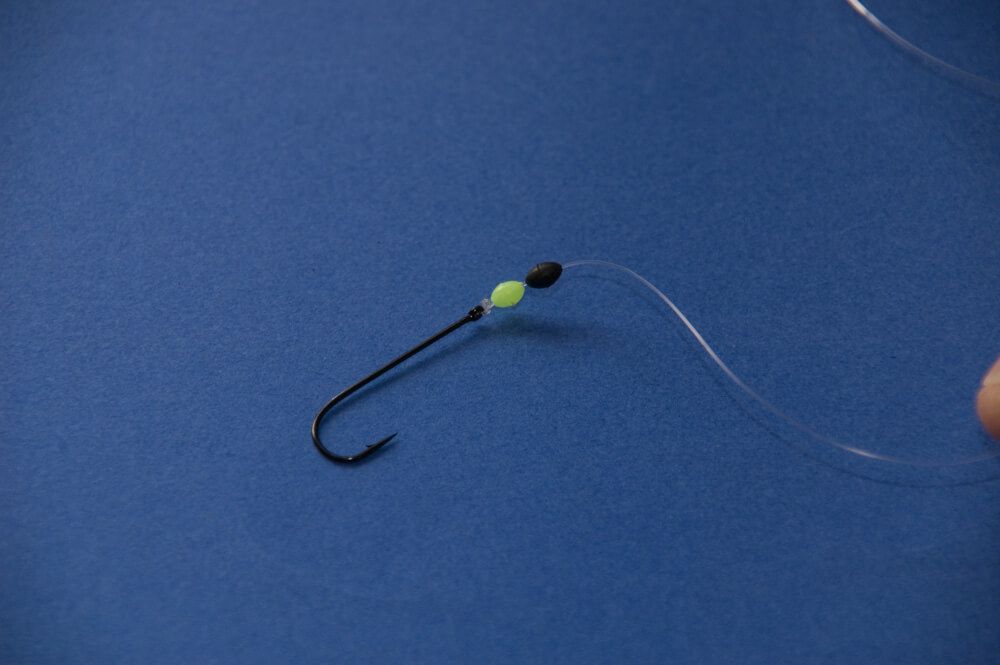
Put the bottom hook in to the lower inverted Multi Clip, slide the Multi Clip up the rig body until the hook snood comes just tight. Lightly close the crimps just enough on to the rig body line to hold the Multi Clip in position with the hook snood under reasonable tension.
Repeat sequence 10 for the top hook snood.
SAKUMA SLIDING RIG CRIMPS
The reason I use the Sakuma sliding rig crimps to hold the Multi Clip in place is that this means that I can tension these just enough to hold the hook and snood in the Multi Clip, but under casting tension the Multi Clips can slide down the rig body slightly avoiding the hook snoods stretching and eventually failing to sit tight in the Multi Clip.
The other advantage to the sliding Multi Clip is that this also means that should a hook snood get damaged in any way or a hook lost, then I can retie the hook snood and easily readjust the Multi Clip to suit without destroying the whole rig if I was using a fixed bait clip unable to slide.
Another big mistake many newcomers, and surprisingly many more experienced rig builders make, is that they make their bait clips fully fixed in position. ALL bait clips should be allowed to slide at least a half inch or so to protect the hook snood from stretch immaterial of clipping up or down.
WHY THIS RIG?
I use this rig for medium to long range fishing throughout the year for spring turbot, flounder, eels, dabs, dogfish, plaice and school bass. In summer changing the luminous bead, which catches extra fish when night fishing, for a floating bead it becomes my main shore bream rig. Add attractor beads in different colours and again it picks up summer plaice by day, even gurnards. In autumn it’s the best rig I have for whiting when fishing the ebb, plus takes longer range dabs, flounders, schoolies, codling (when there’s some to catch), pout, poor cod, rockling and dogs. And in the winter when the sea is well coloured and rough, this streamlined rig gets baits out to massive distances and picks up mainly coalfish, dabs, flounders, whiting, codling etc.
I favour this rig over all others for general fishing as it puts a longish hook snood hard on the seabed which is deadly for flatfish, but has the top snood likely to move about more in the surf to target off the seabed swimmers such as whiting, coalfish and school bass, especially when casting to medium range and fishing to a fully tight line in deeper water.
This rig is also much simpler to initially tie and set up than the Loop or Portsmouth rig while fishing. You can also make the top snood longer and the lower snood shorter, or vice versa, to give the longer snood bait improved presentation in shallow clear water when targeting shy biting fish.
You’ll also note that the rig is extremely streamlined and uses minimal components again aiding casting distance and cutting down on visual impact to the fish when fishing in daylight.
The other advantage with a clipped up rig is that during casting, air pressure is keeping the bait tight on the hook and inside the hook bend maintaining bait presentation, which is something newcomers to rig building often struggle with, even when using bait stops on the hook snoods on more commonly used clipped down rigs.
If you prefer you can substitute the Fluoro carbon for clear mono! I know many of you won’t use Fluoro carbon because of the price and fair enough, but I prefer it because it lasts longer as a hook snood than normal mono having a far higher abrasion resistance which protects the snood from rubbing on sand and rougher ground, so it sort of pays for itself in the long run. Also it loses you less fish such as dogs, rays and huss when in contact with their teeth should you hook these fish inadvertently which is always possibility. It’s stiffer and tangles less than mono when fishing inside turbulent surf tables, plus is less visible to the fish when fishing in calm, clear seas.
A recent question asked very simply, what was my favourite beach rig and the one I most commonly use? Not easy to answer for me being a full all rounder with literally scores of different rigs in my rig wallet to cover all the different situations and species I encounter. However I’ve settled on the two-hook clipped up rig, which I build slightly differently to those used by some other anglers. It is also one of the least used rigs by anglers elsewhere yet, is my most effective for general species.
TOP TIP
To build this rig you need to adapt a current rig accessory, the Mustad Multi Clip.
These are universal clips mainly made for holding longer hook snoods in place when clipping down. These have a ring at one end and a dog leg clip at the other. They are also small in comparison to standard bait clips.

Some years ago a friend and I realised that by cutting off the ring this makes the Multi Clip in to the smallest, neatest bait clip around. It’s basically a hollow coil of wire which the rig body line can slide through. I use these exclusively on many of my rigs nowadays instead of plastic bait clips which generally are too big and clumsy for small species rigs and certainly too obtrusive when fishing in daylight.

TWO-HOOK CLIPPED UP BUILD SEQUENCE
The build sequence is simple.
Start with 40-inches of 60lb clear mono.
At one end tie on a Gemini Lead Link.

Now slide on a rig crimp, 3mm rig bead, size 10 rolling swivel, another bead and rig crimp. Crimp these in place 1-inch above the lead link.

Slide on a Sakuma sliding rig crimp, a 3mm bead, the cut down Multi Clip in the inverted position, another bead and another crimp. Leave these loose for now.

Slide on another crimp, bead and swivel sequence.
Slide on another sliding crimp, rig bead and inverted Multi Clip sequence.
Finish the main rig by tying on a strong size 4 rolling swivel.
The bottom and top hook snoods are 12 to 15-inches of 20lb Fluoro carbon.

After tying to the snood swivels slide on a large rubber rig stop, then a single small luminous bead, and finish with a size 2 Kamasan Aberdeen B940 or Sakuma equivalent.

Put the bottom hook in to the lower inverted Multi Clip, slide the Multi Clip up the rig body until the hook snood comes just tight. Lightly close the crimps just enough on to the rig body line to hold the Multi Clip in position with the hook snood under reasonable tension.
Repeat sequence 10 for the top hook snood.
SAKUMA SLIDING RIG CRIMPS
The reason I use the Sakuma sliding rig crimps to hold the Multi Clip in place is that this means that I can tension these just enough to hold the hook and snood in the Multi Clip, but under casting tension the Multi Clips can slide down the rig body slightly avoiding the hook snoods stretching and eventually failing to sit tight in the Multi Clip.
The other advantage to the sliding Multi Clip is that this also means that should a hook snood get damaged in any way or a hook lost, then I can retie the hook snood and easily readjust the Multi Clip to suit without destroying the whole rig if I was using a fixed bait clip unable to slide.
Another big mistake many newcomers, and surprisingly many more experienced rig builders make, is that they make their bait clips fully fixed in position. ALL bait clips should be allowed to slide at least a half inch or so to protect the hook snood from stretch immaterial of clipping up or down.
WHY THIS RIG?
I use this rig for medium to long range fishing throughout the year for spring turbot, flounder, eels, dabs, dogfish, plaice and school bass. In summer changing the luminous bead, which catches extra fish when night fishing, for a floating bead it becomes my main shore bream rig. Add attractor beads in different colours and again it picks up summer plaice by day, even gurnards. In autumn it’s the best rig I have for whiting when fishing the ebb, plus takes longer range dabs, flounders, schoolies, codling (when there’s some to catch), pout, poor cod, rockling and dogs. And in the winter when the sea is well coloured and rough, this streamlined rig gets baits out to massive distances and picks up mainly coalfish, dabs, flounders, whiting, codling etc.
I favour this rig over all others for general fishing as it puts a longish hook snood hard on the seabed which is deadly for flatfish, but has the top snood likely to move about more in the surf to target off the seabed swimmers such as whiting, coalfish and school bass, especially when casting to medium range and fishing to a fully tight line in deeper water.
This rig is also much simpler to initially tie and set up than the Loop or Portsmouth rig while fishing. You can also make the top snood longer and the lower snood shorter, or vice versa, to give the longer snood bait improved presentation in shallow clear water when targeting shy biting fish.
You’ll also note that the rig is extremely streamlined and uses minimal components again aiding casting distance and cutting down on visual impact to the fish when fishing in daylight.
The other advantage with a clipped up rig is that during casting, air pressure is keeping the bait tight on the hook and inside the hook bend maintaining bait presentation, which is something newcomers to rig building often struggle with, even when using bait stops on the hook snoods on more commonly used clipped down rigs.
If you prefer you can substitute the Fluoro carbon for clear mono! I know many of you won’t use Fluoro carbon because of the price and fair enough, but I prefer it because it lasts longer as a hook snood than normal mono having a far higher abrasion resistance which protects the snood from rubbing on sand and rougher ground, so it sort of pays for itself in the long run. Also it loses you less fish such as dogs, rays and huss when in contact with their teeth should you hook these fish inadvertently which is always possibility. It’s stiffer and tangles less than mono when fishing inside turbulent surf tables, plus is less visible to the fish when fishing in calm, clear seas.
